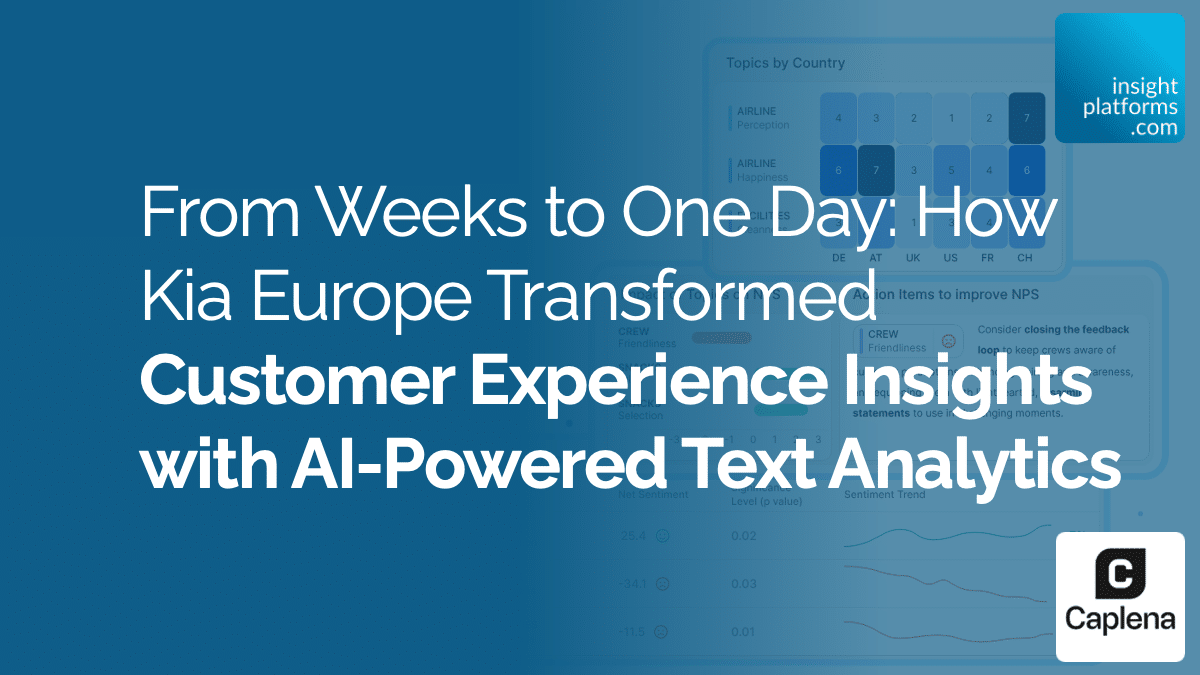
From Weeks to One Day: How Kia Europe Transformed Customer Experience Insights with AI-Powered Text Analytics
By Caplena
- article
- AI
- Artificial Intelligence
- Automated Reporting
- Competitor Analysis
- Customer Experience (CX) Feedback
- Feedback Analytics
- Data Analytics
- Data Visualisation
- Machine Learning
- NLP (Natural Language Processing)
- NPS (Net Promoter Score)
- Sentiment Analysis
- Social Media Listening/Intelligence
- Text Analytics
- Trend Analytics
- Trend Monitoring
In 2022, if you had asked Kia Europe’s customer experience team whether their electric vehicle customers had different expectations than traditional internal combustion engine customers, you would have faced a long wait for an answer. The question would have required designing a new survey, fielding it across markets, waiting for responses, and then manually analysing results. The timeline: several weeks. The insight depth: limited to whatever multiple-choice options researchers had anticipated. The organisational ownership: unclear, with fragmented teams looking at different data across regions and verticals.
Today, that same question receives an answer within 24 hours, complete with root cause analysis and specific recommendations. This transformation – from weeks to one day, from surface responses to strategic depth – illustrates how AI-powered text analytics is reshaping customer experience functions at scale. Kia Europe’s journey over the past three years offers a compelling case study in what it takes to modernise insights operations and, critically, what results become possible when you do.
This article covers part of the case study “Putting Feedback to Work Across Kia Europe” presented at the Insights to Action Summit in October 2025. Rewatch the webinar here:
Electrocharged Insights: Putting Feedback to Work Across Kia Europe
The Starting Point: Rich Data, Limited Insights
Kia Europe was not starting from zero. The organisation collected approximately 150,000 customer comments annually across various touchpoints in the customer journey. They had assembled a technology stack including Google Translate for multilingual feedback, Tableau for visualisation, and various tools for sentiment analysis. On paper, they had the ingredients for a robust customer insights program.
In practice, they faced the challenge that plagues many organisations sitting on large volumes of unstructured feedback: data richness that never quite translates into actionable insight. Comments sat in isolation, disconnected from broader patterns. Analysis required extensive manual effort, creating bottlenecks that limited how many questions the team could realistically address. And perhaps most problematically, insights remained fragmented across different regional and functional teams, preventing the holistic 360-degree customer view that effective experience management requires.
The organisation recognised that improving this situation would require more than incremental refinement of existing processes. It would require fundamental transformation in how they approached customer feedback – the technology enabling analysis, the processes for extracting insights, the organisational structures for sharing findings, and the culture around customer-centricity.
The Four-Step Framework
Kia Europe’s transformation journey followed four essential components, each building on the previous one to create comprehensive capability improvement.
Step 1: Executive Alignment on Customer-Centricity
The foundation began with leadership commitment. Kia’s mission statement includes language about being customer-centric and fostering a people-focused culture – aspirations many organisations share but fewer execute consistently. The CX team recognised that translating mission statements into operational reality requires demonstrating concrete value.
Critically, when proposing investment in improved systems and technology, the CX team did not simply argue that better tools would be good to have. They articulated specific, measurable outcomes that enhanced capabilities would enable, effectively pre-selling the ROI before asking for resources. This approach transformed the conversation from cost justification to investment discussion.
Step 2: Technology Modernisation
With executive support secured, the team addressed the technological foundation. Their existing toolkit – a combination of in-house solutions and point products for translation, visualisation, and basic sentiment analysis – could not deliver the speed or sophistication required for modern customer experience management.
The modernisation centred on implementing an AI-powered feedback analysis platform capable of aggregating data from multiple sources (NPS surveys, customer experience management systems, review sites, social media) and applying advanced natural language processing to understand themes, sentiment, and patterns at scale. Importantly, the technology approach prioritised what might be called “guided AI” – systems that leverage machine learning power while maintaining human oversight and quality control at critical points.
Step 3: Process Development for Insight Generation
Technology alone does not generate insights; it enables them. The third component involved developing systematic processes for how the CX team would handle the questions constantly arising across the organisation. These processes typically begin with driver analysis – identifying which themes or topics have the greatest statistical impact on key metrics like NPS. The team then conducts deep dives into priority areas, combining AI-generated summaries with qualitative human review to develop actionable recommendations.
This structured approach ensures that analysis effort focuses on high-impact areas rather than getting lost in interesting but ultimately inconsequential patterns. It also creates consistency in how insights are developed, making quality more predictable and collaboration with stakeholders more effective.
Step 4: Organisational Enablement and Insight Democratisation
The final component addresses perhaps the most challenging aspect of insights transformation: ensuring that analysis actually drives action. Kia Europe approached this through multiple mechanisms operating at different organisational levels.
At the executive tier, quarterly meetings focus on NPS trends and major drivers of change. At the operational level, monthly cross-functional sessions examine what specific improvements can be implemented based on recent learnings. Market managers receive direct consultation on regional findings. Individual dealers access insights specific to their operations, enabling localised improvement initiatives.
Critically, the team is moving toward self-service access, where stakeholders across the organisation can directly explore customer feedback relevant to their domains rather than waiting for the CX team to run analysis. This democratisation dramatically expands insight consumption while freeing the central team to focus on higher-value interpretation and recommendation development rather than serving as a bottleneck for every data request.
The Results: Six Points and 250,000 Comments
The question that opened this article, “do EV customers differ from ICE customers?”, has a clear answer today: yes, particularly around the handover experience. This insight emerged from analysis across 250,000 customer comments and led to specific interventions, most notably customised training programs for dealer networks on the unique questions and concerns that arise with electric vehicles.
The measurable impact: a six-point NPS improvement for EV customers over three years. In NPS terms, where scores are notoriously difficult to move, six points represent substantial progress. More importantly, the improvement is directly traceable to specific actions informed by customer feedback analysis – the type of causal connection that transforms insights from interesting information into strategic assets.
But the quantified NPS improvement tells only part of the story. Equally significant is the organisational transformation in how customer feedback functions. Questions that once required weeks now receive answers in a day. Analysis that once stopped at topline numbers now includes root cause understanding. Insights that once lived in siloed teams now flow across the organisation. The CX function has evolved from a reactive reporting role to a proactive strategic partner.
Lessons for Other Organisations
Several elements of Kia Europe’s approach merit particular attention for organisations considering similar transformations. First, the iterative implementation strategy involves starting small with one use case and one data source, rather than attempting to solve everything simultaneously. This approach reduces risk, enables learning, and builds organisational confidence through early wins.
Second, the emphasis on demonstrating ROI before requesting investment. Many transformation initiatives fail not because the technology disappoints but because organisational support erodes when results take longer or look different than what stakeholders expected. Pre-selling outcomes creates aligned expectations and sustained commitment.
Third, the recognition that technology modernisation is necessary but insufficient. Equal attention to process development and organisational enablement separates successful deployments from those that deliver impressive capabilities that somehow never quite drive business impact.
Finally, the commitment to democratisation alongside centralised expertise. The CX team maintains analytical rigour and methodological standards while expanding access to insights across the organisation. This balance – between specialisation and democratisation – increasingly defines how high-performing insights functions operate.
The transformation from weeks to one day represents more than speed improvement. It represents a fundamental change in what customer experience insights can contribute to organisational strategy and operations. For companies navigating similar journeys, Kia Europe’s experience offers both a roadmap and evidence that the destination justifies the effort.
This article covers part of the case study “Putting Feedback to Work Across Kia Europe” presented at the Insights to Action Summit in October 2025. Rewatch the webinar here:







